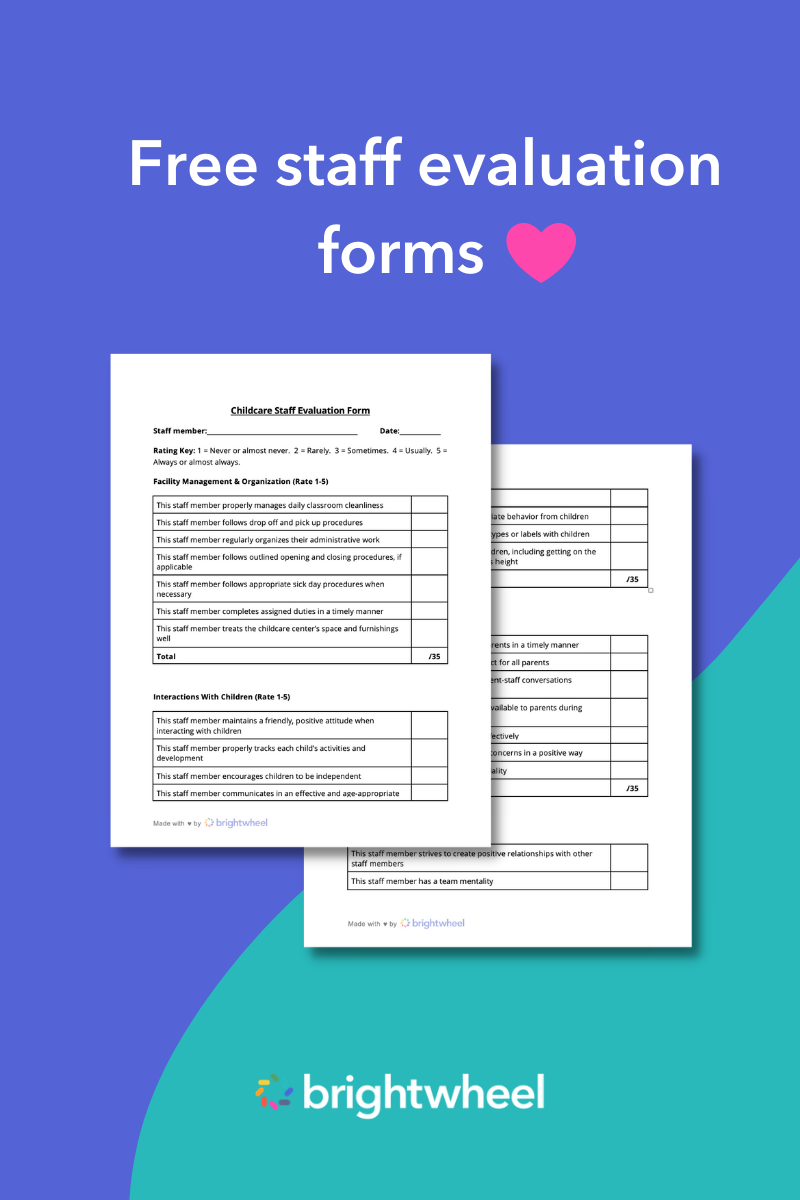Conducting staff evaluations at your childcare center can have a positive impact on your business. Having structured conversations with staff about their performance helps everyone by highlighting strengths, outlining a clear path for improvement, and reiterating how critical each person is to the success of your program.
Using a preschool teacher evaluation form lays the groundwork for a successful performance assessment, creating a workplace culture that prioritizes feedback and professional development. In this article, we'll explore how to conduct a preschool teacher evaluation and the pros and cons of tying compensation to performance evaluations.
Download free preschool staff evaluation forms here!
The importance of a preschool staff evaluation
Staff evaluations allow each employee to understand how their own performance and goals contribute to and impact the overall goals and success of the business. Additionally, regular preschool staff evaluations help your employees feel valued and connected to their work. Your employees’ connection to their work can benefit everything from day-to-day operations to long-term employee retention.
Regular preschool staff evaluations:
- Optimize your workplace for improvements by bringing up any areas for improvement as they emerge.
- Create a positive workplace where staff get feedback and valuable one-on-one face time with their supervisor to address any concerns.
- Build a supportive environment for your employees to develop and bring new ideas to the table, strengthening your program overall.
How to conduct a preschool teacher evaluation
With the proper preparation and approach, you can make evaluation season a time that your preschool teachers look forward to. Use this time to review each staff member’s progress and achievements, and also allow staff the opportunity to thoroughly express their satisfaction or dissatisfaction with their role and work environment.
With brightwheel's childcare forms you can easily create custom fillable PDFs and forms directly in brightwheel and share them with staff to complete. View form status, approve, or request changes in one central dashboard, saving you time and keeping your forms organized.
Keep these best practices in mind as you conduct your preschool teacher evaluations:
- Conduct preschool staff evaluations annually or biannually
- Use a comprehensive preschool teacher evaluation form
- Require staff to complete a self-evaluation
- Gather performance feedback from other team members
Conduct daycare staff evaluations annually or bi-annually
Staff evaluations are often called “annual reviews” because many companies do them once per year at the same time. Childcare centers can aim to evaluate staff formally at least once a year, however it may also be appropriate to conduct less formal check-ins every quarter or at the end of every session.
Keep in mind that there may be legal regulations determining how often you have to evaluate your facility and staff that are set by your state or country. For example, the state of Pennsylvania specifies that the director of a childcare center must provide a written evaluation for staff members once per year at minimum. Follow regulations, but consider adding in more evaluations if you are only required to assess annually or semi-annually.
Whatever frequency you decide, it is important to schedule your preschool teacher evaluations in advance so that your staff has ample time to prepare. Your formal performance evaluation period can happen at the same time each year so your employees know when to expect them.
However, you don't need to wait for a formal evaluation to pull out a preschool teacher evaluation form. Since these forms outline expectations for workplace performance and action plans to achieve goals, you can and should revisit evaluations regularly to track progress towards those goals.
Throughout the year, keep detailed notes on your staff’s achievements, strengths, and areas for growth to ensure you are prepared when evaluation time comes around. Reference the goals from previous evaluations and note specific areas where employees continue to excel and any areas where you’ve seen improvement or progress.
Make your evaluation forms readily accessible to your staff. Encourage them to use their past evaluations as they monitor their own professional development goals.
Keep an open line of communication between you, your staff, and families with a communication app like brightwheel. Give staff an easy tool to message parents directly and foster a sense of community in your program by messaging staff individually or as a team and answering questions instantly.

Use a comprehensive preschool teacher evaluation form
It's important that your staff evaluations cover all responsibilities of a staff member's role. Think about each of the areas you might refer to in a job description and make a section on your preschool teacher evaluation form for questions about each of them.
Download free preschool staff evaluation forms here!
For example, your staff evaluation form might include the below sections:
- Facility management and organization: Describe how this staff member maintains a clean, organized learning environment.
- Interactions with children: Discuss this person's behavior management skills in the classroom and how they teach, speak to, and engage with children.
- Interactions with families: Summarize their communication style with families. Are they clear, respectful, and welcoming or does this area need improvement?
- Interactions with other staff: Describe how they interact and collaborate with other teachers and team members. Include examples where applicable.
- Plans for activities and age-appropriate materials: Consider your teachers' lesson planning skills. Are the activities aligned with learning objectives for your program and do they incorporate developmentally appropriate materials?
Ask your staff for feedback on the forms you create and incorporate their suggestions. Although it will make your evaluation process more time-consuming, discussing the whole range of an employee's work keeps you focused on your center's gold standard of performance. A teacher is responsible for a variety of tasks and using a thorough evaluation form allows you to account for their strengths and areas for improvement in each section.
Using a comprehensive preschool teacher evaluation form also ensures that you're providing a fair and consistent evaluation of your staff and their work. Your staff needs to know exactly what is expected from them and how they’ll be assessed on it during a preschool staff evaluation. Determine the rating scale you will use and make sure employees clearly understand what each rating means. For example, you could rate employees’ performance in each specific category on a scale from 1 to 5, with 1 corresponding to “never or almost never meets expectations” and 5 corresponding to “always or almost always meets expectations”.
Require staff to complete a self-evaluation
Performance review experts at Lattice pinpoint self-evaluations as a key part of any feedback cycle. They “help employees internalize what they are good at and how they can improve, ...[and] show not only how open the employee is to change and growth, but how much they understand about their own performance.”
From an employee's perspective, self-evaluations provide valuable time to reflect on their performance. In the early childhood education field, there is no shortage of things to do every day. Carving out space for self-evaluation supports your employees’ professional development.
From a management perspective, self-evaluations can provide valuable insight on an employee’s work habits and perspective. It also allows employees to feel more engaged in the performance review process by identifying any areas where they’d like to improve and giving feedback on company culture.
Ask about all of the same things as your preschool teacher evaluation forms. Use the same rating scale so employees can accurately assess their own performance and encourage them to be as honest as possible. Empower employees by asking them to identify their greatest strengths and stress that it will not be seen as bragging. In addition, ask employees to describe their biggest opportunities for improvement and emphasize that this part of the self-evaluation will be used to come up with goals and learning opportunities, free of negative judgment.
To use self-evaluations effectively, compare them to manager assessments. Any discrepancies can reveal blind spots for staff and managers that provide a valuable opportunity to sync.
If a staff member feels they're not performing well in an area you think they are, that can be a great time to boost confidence and empower staff. If you feel they're underperforming and they feel they're doing well, you can take the opportunity to go over their routines and approaches to see where problems may lie.
Gather performance feedback from other team members
Peer feedback, also referred to as a 360-degree performance review, is an effective way to get feedback for staff members on larger teams, such as those with four members or more. Collaboration and other interpersonal skills are vital to successful teams. A 360 review offers a holistic approach to assessing staff performance. Use peer feedback in conjunction with a supervisor’s performance evaluation for best results.
Here are a few considerations when conducting a 360-degree performance review:
- Understand team dynamics. Be aware of the pros and cons of conducting a 360 review. Some team dynamics may not be suitable for peer feedback if the team is experiencing challenges or conflict.
- Set up staff for success. Giving and receiving feedback may be uncomfortable for staff members. In preparation, you may share the intentions of a 360 review in advance and create a safe space to discuss any feelings it may bring up and how the results will be used to support them professionally.
- Give staff a self-evaluation. Have your staff members conduct a self-evaluation using the same questions that are in the 360 review. This allows staff to understand how they will be evaluated and it also serves as a time of reflection in preparation for the discussion.
- Use the same review for everyone. Using the same feedback form and questions for everyone participating in the review will eliminate bias and assist in gathering a true account of the individual’s performance.
The purpose of a 360 review is to offer a well-rounded perspective. For example, as a director, you may observe a staff member’s organization, timeliness, and teamwork, while fellow staff members will be able to assess their collaboration style, how they interact with families, and their willingness to help others.
Additionally, multiple reviews eliminate bias. If one person says this staff member is non-collaborative but three other reviews rave about their helpfulness, you can place more weight on the latter.
Pros and cons of tying compensation to performance evaluations
It can be beneficial to both you and your staff members to connect compensation discussions to performance evaluations, but there are various factors to consider.
Benefits
The benefits of tying compensation to performance evaluations can include:
- Motivating staff members to go the extra mile: An increase in their paycheck can reward a job well done and encourage great work to continue.
- Attracting talented employees to your business: Offering a compensation plan that includes a performance element can bring high performers and ambitious candidates to your staff.
- Offering clear metrics and paths to pay increases: Setting up performance-based pay can help you to assure clarity and consistency among your employee evaluations. It will be easy to eliminate any intangible metrics and confusing parameters around compensation, and you’ll have the opportunity to be very clear and specific about what type of work performance merits an increase in pay.
Disadvantages
Depending on what makes the most sense for your business, you may decide to evaluate the idea of keeping compensation conversations separate from performance reviews.
The disadvantages of attaching compensation to performance can include:
- Distracting from job-related feedback: Sometimes when job performance and compensation are discussed together, the feedback and performance section can get lost. If the staff member is solely focused on the pay portion, coaching on critical job-related performance may not be heard and implemented.
- Taking extra time to outline clear expectations and metrics: When using a performance-based pay model, setting up clear tiers and milestones is important for the employee to understand what they need to do to receive a change in pay. It can be time consuming to build and continually adjust to current business needs.
Reviewing these options as they apply to your own business and individual staff members can help you to decide whether or not this performance evaluation structure is right for you.
Implement preschool staff evaluations to meet and exceed your goals
Every owner or manager of a childcare center wants to make their workplace the best it can be for the children in their care and for their employees—which is easier said than done.
Conducting staff evaluations is one of the best ways to show your staff that you are invested in their professional development and value their impact on your business. Using a tool like a preschool teacher evaluation form is a great way to track each staff members’ unique strengths and contributions towards meeting and exceeding your childcare center's goals.
Brightwheel is the complete solution for early education providers, enabling you to streamline your center’s operations and build a stand-out reputation. Brightwheel connects the most critical aspects of running your center—including sign in and out, parent communications, tuition billing, and licensing and compliance—in one easy-to-use tool, along with providing best-in-class customer support and coaching. Brightwheel is trusted by thousands of early education centers and millions of parents. Learn more at mybrightwheel.com.








